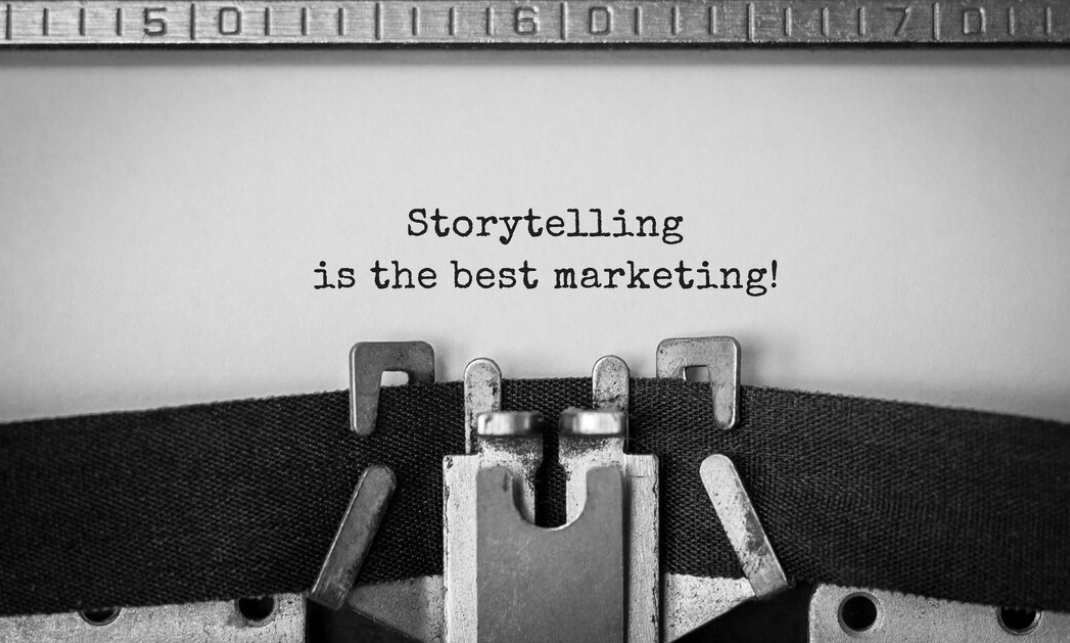
In today’s digital landscape, storytelling has become a vital component of successful social media marketing strategies and, in turn, online marketing strategies. You might be familiar with the term, but unsure of its significance or how to implement it effectively.
That’s where our crash course comes in! We’ve curated simple yet powerful storytelling techniques that you can put into action right away. Get ready to transform your marketing approach and engage your audience like never before!
What is storytelling?
If you have a passion for books, it’s only natural to constantly seek out new reads and explore various authors’ works. Among the plethora of writers out there, you undoubtedly have a few favorites whose books you eagerly buy and devour. These favored authors have succeeded in captivating your interest and sparking a connection with you. What sets them apart from others is their ability to tell compelling stories.
But what exactly is storytelling, and is it merely the act of narrating tales through the written word? Well, that’s just one facet of it. In reality, storytelling transcends the boundaries of literature. Stories are not confined to books alone; they are a universal language accessible to everyone. They manifest in various forms of communication, such as casual conversations, written documents, and even blog posts online. At the core of storytelling lies the ability to establish connections between people.
So, how do we precisely define “storytelling”? Storytelling is the art of using facts and narratives to communicate and convey specific messages to an audience. Stories are brought to life through spoken words and actions, often accompanied by improvisation, theatrics, or embellishments. It fosters an active imagination within the listener and involves a two-way interaction between the storyteller and their audience.
Regardless of the medium, all forms of storytelling share a common characteristic: empowering listeners to visualize vivid sensory elements of the narrative based on the storyteller’s performance and their own experiences and interpretations. In this way, storytelling becomes an immersive and engaging experience for both the narrator and the listeners.
What is social media storytelling?
As previously mentioned, stories extend far beyond the realms of books or movies; nowadays, social media has become a platform for countless storytelling ventures.
You might stumble upon a Facebook status where someone recounts their journey to becoming a successful marketer, or witness a composer unfolding the inspiration behind their latest song through a YouTube vlog. In both cases, storytelling is at play, specifically, social media storytelling. Social media storytelling involves utilizing social media platforms to share narratives about your brand, products, or any topic that captivates your audience.
However, it’s essential not to view storytelling on social media as merely another tactic to sell products or services. Rather, it offers a unique opportunity to expose your brand’s essence to your audience and convey its true essence. Similar to the stories we typically read in books, social media stories should ideally have a beginning, middle, and an end, often with a climax or conflict. They often convey moral lessons, thoughts, beliefs, or philosophical insights about the world and humanity. Social media storytelling in marketing is no exception. If you tell stories on social media solely for the purpose of selling something, they are more likely to come across as pushy promotions or slick sales messages. These tactics often fall flat and fail to leave a lasting impression on the audience.
A remarkable example of storytelling can be found in Google’s #StayHomeSaveLives campaign. This hashtag resonated with people worldwide, urging them to stay at home and unite in the fight against the pandemic. Google cleverly compiled top searches during this challenging time into a heartwarming and inspiring narrative on social media. The campaign showcased the global efforts to support healthcare workers and encouraged people to maintain social distancing and quarantine to curb the spread of Coronavirus. Such storytelling not only engages audiences but also imparts a meaningful message that leaves a lasting impact.
Online storytelling
What exactly is online storytelling? It involves using your online channels, such as your website, LinkedIn, Facebook, and more, to tell stories or convey your message in a narrative style. This can encompass your brand story, specific ideas, concepts, testimonials from former clients, and much more.
The narrative style of storytelling is far more appealing than simply sharing information about your products, offers, or why you might be superior to your competitors.
If you’re a self-employed service provider, such as in consultancy or coaching, you might be wondering if you have anything to share, particularly during these times when in-person client interactions are limited. You might also be concerned about breaching client confidentiality or if your followers would be interested in your content.
The answer is a resounding yes! By integrating storytelling into your strategy, you can bring seemingly insignificant or small facts and events to life, inspiring and motivating your audience while effectively promoting your services and showcasing your expertise. This approach works wonders for personal branding and can truly make your online presence stand out.
1. The before-and-after method:
- Describe the problem;
- Outline what would be ideal or desirable for your target audience, using phrases like “but imagine if…”;
- Explain the solution.
This method is suitable for various types of posts, including:
- Links to interesting articles or blogs on your website;
- Tips, showcasing your expertise in your domain;
- Email campaigns, where you can promote your free e-book containing the solution to the problem at hand, downloadable by providing an email address (which also subscribes users to your newsletter);
- Your own offer.
For instance, in a LinkedIn post by James Parry, the ideal situation is presented with the phrase “the world is your oyster,” and immediately, the solution to the problem is offered in the same sentence.
2. The monomyth
In a monomyth, the hero of the story is experiencing difficulties or hardships. As a result, he has gained wisdom or accomplished something great.
For which posts?
your personal story: how it all started, what happened next, where you ended up afterwards and where you are now
the story of a client, whose problem was solved by your product or service
Example: In this video, consultant Elizabeth Dankoski tells her personal story about how she became a successful consultant.
3. Simon Sinek’s Golden Circle
In a monomyth, the hero of the story faces challenges and hardships, leading to the acquisition of wisdom or the achievement of something extraordinary.
This storytelling approach can be utilized for various types of posts, including:
- Your personal story: Share your journey, starting from how it all began, the events that unfolded, where it led you, and where you find yourself now;
- The story of a client: Narrate how your product or service effectively solved a client’s problem, showcasing the transformation they experienced.
For example, consultant Elizabeth Dankoski beautifully shares her personal story in this video, recounting her path to becoming a successful consultant.

4. The emotionally charged, personal story
Harness the power of emotion – a well-known fact among marketing experts. Infuse your content with emotionally charged, personal stories that incorporate strong and even slightly provocative language. Craft a captivating first sentence that instantly grabs attention.
A valuable variation of this approach is the three-part storytelling technique by renowned author Dale Carnegie:
- Share a relevant, personal experience: whether it’s your own or that of a client;
- Describe the actions taken to overcome the arising challenge;
- Explain the precise benefits derived from these actions.
This storytelling technique can be effectively used for various types of posts, such as:
- Positive testimonials from satisfied (former) clients, showcasing their experiences with your product or service;
- Tips or life lessons derived from specific events or experiences, which provide valuable insights for your audience.
If you’re unsure about mentioning a client in a testimonial on social media, simply ask for their permission. If necessary, use a different, fictional name or state that the client preferred to remain anonymous. Alternatively, you can omit the client’s last name. For instance, in this post, sales and business consultant Adrian Miller employs powerful words to captivate the audience right from the start.
5. Starting in the heat of the action
To grab attention effectively, begin your story in the midst of the action, at the heart of the excitement. Start by sharing the most thrilling part of the narrative, leaving the preceding events for later.
Think of it like a movie trailer, teasing the audience with captivating scenes that pique their curiosity and leave them eager to uncover what unfolds next. This approach entices readers to delve into the entire post, just as a trailer encourages viewers to watch the full movie.
Another effective strategy is to commence with an unexpected or peculiar statement or idea, leaving readers intrigued and wanting to know more. Then, proceed to explain the rationale behind this intriguing opening.
This storytelling technique can be used for a variety of posts, including:
- Your own vision or opinion, introducing it with an exciting moment or intriguing statement;
- Your personal history or story, beginning with a gripping incident that draws readers in;
- Positive testimonials from satisfied (former) clients, kicking off with a fascinating aspect of their experience.
For instance, in this post by Matteo Grassi, he starts with the fact that he began with limited funds, followed by an explanation of the events leading up to this point (“multiple failed projects”). This approach captivates the audience and sets the stage for his main message.
6. Adding emotional weight to a problem
This copywriting technique is widely popular and effective. The approach involves:
- Presenting the problem: Clearly outlining the issue at hand;
- Adding emotional weight to the problem: Engaging the target audience by evoking emotions and interest;
- Explaining the solution: Providing a clear and effective resolution to the identified problem.
This technique can be effectively used for various types of posts, including:
- Your own ideas, where you showcase your expertise by presenting a problem and offering a solution that resonates with your audience;
- Your own offer, where you highlight a problem your product or service addresses and provide a compelling solution.
For instance, in this post, HR coach Erin Lewber skillfully introduces the problem and adds emotional weight by using the phrase “you’re passed over.” She then provides a valuable tip that effectively solves the initial problem, engaging the audience and showcasing her expertise.
7. Star – chain – hook
Consultant Frank W. Dignan has developed a simple yet highly effective technique:
- Start with a positive opening, using phrases like “it is time to…”, “today is the day when…”, or “I have very good news…”. Add smileys or exclamation marks for an extra dose of enthusiasm;
- Sum up a series of compelling benefits, facts, or explanations to create a strong desire in the reader;
- Close with a hook, whether it’s a call-to-action like “go to…” or “contact me on…” or a thought-provoking question that elicits reactions.
This technique can be effectively utilized for various types of posts, including:
- Your own offer, where you use the three-part structure to entice potential customers and showcase the benefits of your product or service;
- Tips and advice, where you present valuable insights in an engaging way, highlighting your expertise in your domain;
- Links to interesting articles or blogs on your website, using this technique to spark curiosity and encourage readers to explore further.
For instance, in this post by coach Trace Fisher, the three-part structure is skillfully employed, capturing attention with a positive opening, presenting convincing benefits, and concluding with a strong call-to-action or hook.
8. The fairytale technique
Emma Coats from Pixar crafted an impressive set of 22 rules for creating the perfect story. While she used these rules in numerous movie storylines, they are equally applicable to content creation. Interestingly, this technique has a history spanning thousands of years and serves as the foundation for fairy tales and stories with happy endings. Its simplicity makes it accessible even to children.
The structure is as follows:
- Once upon a time… x years ago…;
- Every day… (This is what life looked like.);
- And because of that…;
- But this is not how I/he/she wanted it, this was not good, or then… happened…;
- But then… (The solution appears.);
- Happy ending.
This storytelling technique can be effectively used for various types of posts, including:
- Positive testimonials from satisfied (former) clients, using this structure to present their journey and the positive outcomes they experienced;
- Your personal story, where you outline your history, the challenges faced, the turning points, and the ultimate positive results.
For example, in this post by business coach Justin Welsh, he skillfully applies this storytelling technique to narrate his personal journey, mentioning the years, the changes he desired, the consequences of his actions, and ultimately achieving positive results.
Tips to Enhance Your Content Creation
When creating content, remember to refer to this handy checklist:
- Start by asking yourself: Will this message captivate my target audience? How can I effectively convey this story? What format will appeal most to my audience: images, videos, bold text, or smileys?;
- Keep things simple and well-structured. Utilize short sentences, lists, and avoid complex vocabulary;
- Engage the imagination of your audience. Utilize powerful images, videos, and compelling language to evoke emotions;
- Grab attention right from the start. Avoid dull or lengthy intros, and make your first sentence impactful;
- Infuse a personal touch into your content, making it relatable and appealing to your audience.
The Significance of Social Media Storytelling
Establishing connections with others through communication is a profound aspect of human interaction. And at the heart of this connection lies the art of storytelling. When a story captures someone’s attention and engages them, a powerful bond is formed.
Storytelling possesses psychological superpowers that make it an invaluable tool in marketing:
- Emotion: Listening to a compelling story triggers personal connections that go beyond theory; it is deeply rooted in fascinating neuroscience. When we hear a story, multiple areas of our brain activate, fostering profound emotional attachments that surpass the impact of mere facts;
- Action: The emotions and connections stirred by stories can significantly influence our behavior. Experiments by neuro-economist Paul Zak demonstrated this phenomenon. For instance, individuals who watched a video about an ill boy experienced higher levels of oxytocin, which motivated them to donate money to a stranger;
- Value: Stories have the unique ability to evoke emotions, sympathy, and action, but they also play a crucial role in shaping how we perceive the value of something. Brands can enhance the subjective value of their products by weaving captivating stories around them;
- Memory: Storytelling is ingrained in our culture and deeply etched in our hearts, forging a strong connection with our memory. Known as “The Story Method” of memorization, storytelling helps us retain information more effectively, making it memorable for an extended period.

How to Master Storytelling on Social Media Platforms?
Storytelling is a powerful tool for building brand personalities and connecting with customers, making it essential for social media marketing. However, with the limitations of some platforms and the ever-changing trends, how can storytellers thrive on social media? Here are some effective approaches for the four most popular platforms: Facebook, Instagram, Twitter, and YouTube.
| Social Media Platform | Storytelling Tips |
|---|---|
| Craft in-depth stories within the word limit to captivate your audience. Share incredible narratives rather than just summarizing key points. | |
| Be a visual storyteller by curating an appealing profile. Utilize the ‘Rule of Thirds’ for visually appealing photo composition. | |
| Create a unique hashtag to spread your brand’s story and encourage engagement. Your hashtag doesn’t need constant trending; focus on its purpose. | |
| YouTube | Utilize video content to capture audience attention. Start a series of high-quality, concise videos about your company, employees, or customers. |
6 Tips and Practices for Successful Social Media Storytelling
Tip 1: Know Your Audience
Understand your audience by identifying customer personas and analyzing platform analytics. This foundation will help you create a compelling story that resonates with your listeners, readers, or viewers.
Tip 2: Develop a Comprehensive Story
Consider your business goals from both short-term and long-term perspectives. Illustrate individual stories in various formats like clips, posts, or images to create a cohesive brand narrative that engages audiences for a prolonged period.
Tip 3: Write Creatively
Even with little writing experience, craft a creative and intriguing storyline that sparks curiosity and captures your audience’s attention.
Tip 4: Make Your Story Meaningful
Go beyond interesting narratives and deliver a story that holds deep meaning for your audience. Provoking emotions and building connections with your brand will encourage engagement and action.
Tip 5: Utilize Social Media Tools
Leverage practical tools such as Instagram stories, Snapchat stories, and Facebook stories to simplify storytelling. Target millennials and young demographics through these platforms and use social media scheduling tools to maintain a constant flow of engaging content.
Tip 6: Leverage Storytelling Archetypes
Utilize powerful storytelling techniques:
- Synecdoche: Use parts of something to represent the whole, like Airbnb adding customer stories to photos;
- Origins: Include your audience from the beginning, engaging in authentic conversations and valuable interactions;
- Spoilers: Intrigue the audience by offering a quick glimpse of the story’s climax, encouraging them to read the complete narrative.
Conclusion
Storytelling is an art that extends beyond a traditional narrative structure. To craft unforgettable stories on social media, utilize the “stories” feature to share sneak peeks of your daily hustle. Showcase videos of satisfied customers sharing their experiences with your brand as a game-changer. However, creating valuable content is not enough; you must also ensure maximum exposure. Use SocialPilot, a powerful tool that boosts your engagement rate and helps you appear in the feeds of active followers. Try its free trial and elevate your storytelling game.